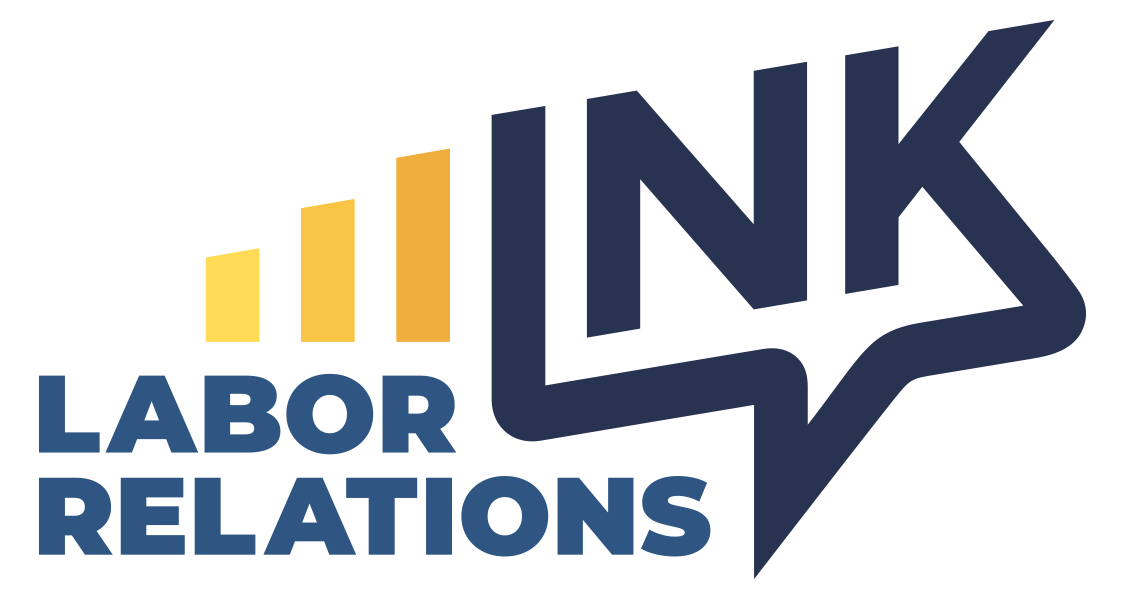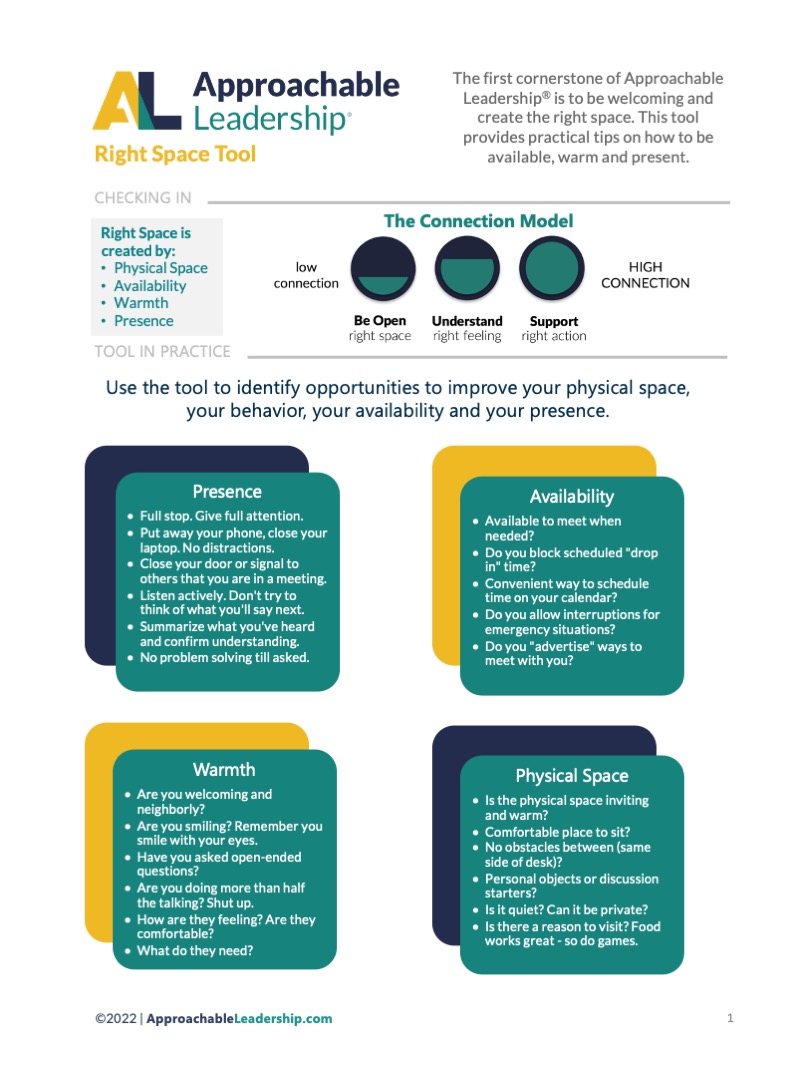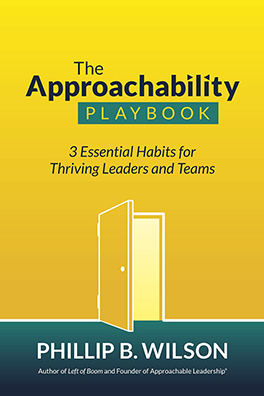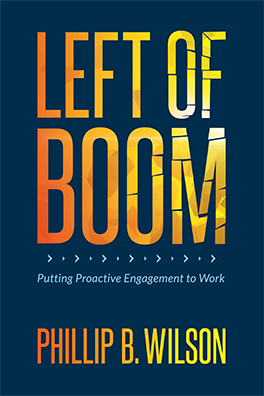 Labor Relations INK In this issue:
Labor Relations INK In this issue:
- Union Bailout Update
- White House Hosts Labor Love-in
- Hoffa Wrist-Slapped for Bribes
- Are You a Good Rich? Or a Bad Rich.
- SEIU Watch, Sticky Fingers and more…
Union Bailout Update  The NLRB issued but another bizarre ruling last week that further establishes a union’s right to trash a company’s reputation just because it can. In the case of Southern New England Telephone Company dba AT&T Connecticut and Communication Workers of America the Board majority has ruled that wearing prison outfits on service calls because you want more money is protected activity. (We only wish we were making this up.) It seems the company failed to adequately make its case that employees doing service calls dressed as inmates with “prisoner of AT$T” emblazon on their backs will sully the company’s public image. Member Hayes in yet another pained dissent lamented, “Imagine that you are a customer of AT&T Connecticut awaiting a service call. The doorbell rings. You open it, and the first thing you see is someone wearing a T-shirt bearing only “INMATE #” on its front.” So go ahead and add prisoner costumes to the list of things a company, its customers and its non-union-drunk employees must now endure along with giant inflatable rats, roaches in the salad bar, Facebook slander, death threats, embarrassing street theater and billboards declaring you a U.N. human rights violator. Oh yes, and Danny Glover. On March 28 the Board sustained a union’s decertification election objection in Jurys Boston Hotel. The union, UNITEHERE, filed ULPs on provisions in the company’s handbook that prohibited employees from soliciting on hotel property, limited their “loitering” on premises and barred them from wearing “emblems, badges or buttons with messages of any kind.” The union knew of those clauses in the defunct handbook for years and made no previous objections to them. The handbook hadn’t been distributed in two years, the policies were not enforced during the election period and the company specifically told employees those policies no longer were in force, yet the Board still ruled there was evidence that the simple existence of those rules at one time “chilled” the election which was decided by a single vote. Employers are reminded to have all handbooks, even outdated ones, reviewed under the light of current Becker Board interpretations. Meanwhile, fittingly, Wilma Liebman, chair of the NLRB, was quoted this weekcomparing labor law to dinosaur DNA. At an appearance at the University of Minnesota Law School, Liebman gave a lecture on “Reviving American Labor Law” in which she admitted that through decades of application labor law has failed to keep up with changes in the workplace and “words like death and dying are commonly used” to describe it. She also admitted that a 1947 provision to the law “guarantees obsolescence” by constraining the board from considering the economic impact of its decisions. “The law is probably in decline,” she said, “but like dinosaur DNA, it is probably worth preserving.” Did these people not see Jurassic Park!? All this talk about obsolescence dovetails nicely into Liebman’s appearance this weekbefore the House Appropriations Committee. While such funding appearances are routine, this one could be spiced up by last month’s failed Congressional attempt to fully defund the NLRB. The Workforce Subcommittee also recently demanded Liebman prove budget cuts to the NLRB truly undermine the Board’s sacred duty to singlehandedly save the labor movement from extinction. ********** White House Labor Love-in
The NLRB issued but another bizarre ruling last week that further establishes a union’s right to trash a company’s reputation just because it can. In the case of Southern New England Telephone Company dba AT&T Connecticut and Communication Workers of America the Board majority has ruled that wearing prison outfits on service calls because you want more money is protected activity. (We only wish we were making this up.) It seems the company failed to adequately make its case that employees doing service calls dressed as inmates with “prisoner of AT$T” emblazon on their backs will sully the company’s public image. Member Hayes in yet another pained dissent lamented, “Imagine that you are a customer of AT&T Connecticut awaiting a service call. The doorbell rings. You open it, and the first thing you see is someone wearing a T-shirt bearing only “INMATE #” on its front.” So go ahead and add prisoner costumes to the list of things a company, its customers and its non-union-drunk employees must now endure along with giant inflatable rats, roaches in the salad bar, Facebook slander, death threats, embarrassing street theater and billboards declaring you a U.N. human rights violator. Oh yes, and Danny Glover. On March 28 the Board sustained a union’s decertification election objection in Jurys Boston Hotel. The union, UNITEHERE, filed ULPs on provisions in the company’s handbook that prohibited employees from soliciting on hotel property, limited their “loitering” on premises and barred them from wearing “emblems, badges or buttons with messages of any kind.” The union knew of those clauses in the defunct handbook for years and made no previous objections to them. The handbook hadn’t been distributed in two years, the policies were not enforced during the election period and the company specifically told employees those policies no longer were in force, yet the Board still ruled there was evidence that the simple existence of those rules at one time “chilled” the election which was decided by a single vote. Employers are reminded to have all handbooks, even outdated ones, reviewed under the light of current Becker Board interpretations. Meanwhile, fittingly, Wilma Liebman, chair of the NLRB, was quoted this weekcomparing labor law to dinosaur DNA. At an appearance at the University of Minnesota Law School, Liebman gave a lecture on “Reviving American Labor Law” in which she admitted that through decades of application labor law has failed to keep up with changes in the workplace and “words like death and dying are commonly used” to describe it. She also admitted that a 1947 provision to the law “guarantees obsolescence” by constraining the board from considering the economic impact of its decisions. “The law is probably in decline,” she said, “but like dinosaur DNA, it is probably worth preserving.” Did these people not see Jurassic Park!? All this talk about obsolescence dovetails nicely into Liebman’s appearance this weekbefore the House Appropriations Committee. While such funding appearances are routine, this one could be spiced up by last month’s failed Congressional attempt to fully defund the NLRB. The Workforce Subcommittee also recently demanded Liebman prove budget cuts to the NLRB truly undermine the Board’s sacred duty to singlehandedly save the labor movement from extinction. ********** White House Labor Love-in
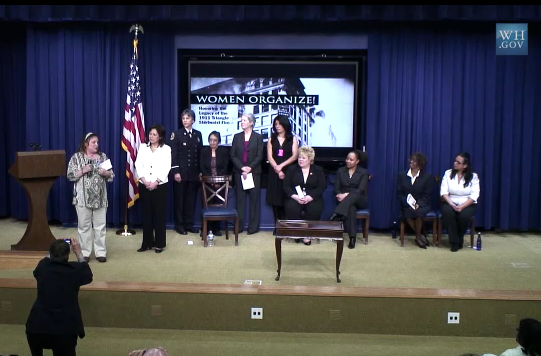 First they billed it as a “Women’s History Month Event Honoring Women with the Courage to Make a Difference sponsored by the new White House Council on Women and Girls”. (Because Men and Boys don’t need White House Councils.) Then it morphed into a “Tribute to Women on the 100thAnniversary of the Triangle Shirtwaist Fire.” Then, at show time, the sign on stage read simply “Women Organize!” but by two minutes into Hilda Solis taking the podium it was clear this was nothing but one big labor lovin’ schmooze fest leading into the kick-off this week of Obama’s 2012 campaign. In her opening remarks, Solis incorrectly stated that the Triangle victims “gave their lives trying to organize,” carrying on the century long tradition of shamelessly exploiting the Shirtwaist tragedy for union aggrandizement. She then reassured the one hundred labor leaders in attendance that the White House knows that when “workers have a voice American workplaces are safer and American families are more secure.” Valerie Jarrett, chairwoman of the aforementioned Women and Girls council, added, “all working men and women benefit from the labor movement… and the balancing of the playing field.” The event then turned to honoring a carefully crafted panel of women bravely seeking a voice at work – an AFSCME childcare provider from Ohio (legislation in Ohio just de-authorized the forced sham unionization of private child care providers), a member of Domestic Workers United (a fully owned subsidiary of SEIU just getting off the ground in NYC), a Walmart worker (natch) and a T-Mobile worker (about to be card checked into AT&T’s CWA unit). Solis also introduced a Hyundai worker (the likely new big UAW target) and several Wisconsin teachers who apparently had not yet missed enough classroom time this semester. A few enlightening/amusing moments came out of the event – Ernestine, the seventy something Walmart employee, mentioned she retired from her union Verizon job in 1999. (And yet she still has to work at Walmart?) Immigrant Lillian from T-Mobile said she was paid very well, “living the American Dream” and treated well at work but still she just doesn’t feel “appreciated” without a union around. When asked by Solis, Ernestine said the hardest part of organizing her coworkers was “talking to some people who have had union jobs before and for some reason are not convinced Walmart should be unionized, I’m not really sure why.” And in closing Solis, the person who oversees both the NLRB and OLM, advised all women feeling “alone and powerless, don’t be afraid to pick up the phone, no matter what your job is, there’s a union out there to help you.”
First they billed it as a “Women’s History Month Event Honoring Women with the Courage to Make a Difference sponsored by the new White House Council on Women and Girls”. (Because Men and Boys don’t need White House Councils.) Then it morphed into a “Tribute to Women on the 100thAnniversary of the Triangle Shirtwaist Fire.” Then, at show time, the sign on stage read simply “Women Organize!” but by two minutes into Hilda Solis taking the podium it was clear this was nothing but one big labor lovin’ schmooze fest leading into the kick-off this week of Obama’s 2012 campaign. In her opening remarks, Solis incorrectly stated that the Triangle victims “gave their lives trying to organize,” carrying on the century long tradition of shamelessly exploiting the Shirtwaist tragedy for union aggrandizement. She then reassured the one hundred labor leaders in attendance that the White House knows that when “workers have a voice American workplaces are safer and American families are more secure.” Valerie Jarrett, chairwoman of the aforementioned Women and Girls council, added, “all working men and women benefit from the labor movement… and the balancing of the playing field.” The event then turned to honoring a carefully crafted panel of women bravely seeking a voice at work – an AFSCME childcare provider from Ohio (legislation in Ohio just de-authorized the forced sham unionization of private child care providers), a member of Domestic Workers United (a fully owned subsidiary of SEIU just getting off the ground in NYC), a Walmart worker (natch) and a T-Mobile worker (about to be card checked into AT&T’s CWA unit). Solis also introduced a Hyundai worker (the likely new big UAW target) and several Wisconsin teachers who apparently had not yet missed enough classroom time this semester. A few enlightening/amusing moments came out of the event – Ernestine, the seventy something Walmart employee, mentioned she retired from her union Verizon job in 1999. (And yet she still has to work at Walmart?) Immigrant Lillian from T-Mobile said she was paid very well, “living the American Dream” and treated well at work but still she just doesn’t feel “appreciated” without a union around. When asked by Solis, Ernestine said the hardest part of organizing her coworkers was “talking to some people who have had union jobs before and for some reason are not convinced Walmart should be unionized, I’m not really sure why.” And in closing Solis, the person who oversees both the NLRB and OLM, advised all women feeling “alone and powerless, don’t be afraid to pick up the phone, no matter what your job is, there’s a union out there to help you.” *********** Should Prospective Members See Union Finances? 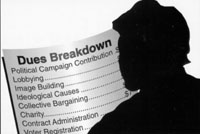 According to Congressional testimony last week by union defender John Logan, Director of Labor and Employment Studies at San Francisco State, the answer is no. In testimony before the House Subcommittee on Health, Employment, Labor and Pensions in a hearing on union accountability and transparency Logan called only upon his experience running a labor study center in San Francisco to conclude that all American union members want to know about their union’s finances can be found in the barebones pre-Bush LM-2. Logan then went on to cite LRI’s use of the new more detailed LM-2 in union campaigns as one compelling reason to revoke the new standards. Logan writes, “One of the largest union avoidance firms in the nation, LRI Consulting Services, Inc. (LRI), tells employers that, ‘Facts drawn from these documents (LM-2s)… will help convince your employees to vote No on election day’…These union avoidance firms, and their clients who are determined to operate union free, have benefitted more from the detailed and readily available financial information contained in the revised LM-2s than have ordinary union members.” One can only conclude then that Prof. Logan sees no need for prospective members to fully examine a union’s finances before voting and he finds something sinister or perhaps damaging in offering them detailed information on a union’s spending habits. The Obama DOL has rescinded Bush Administration T-1 reporting on union trusts and weakened the reporting requirements on LM-2 forms. The DOL has also significantly decreased the number of union audits. Diana Furchtgott-Roth, Senior Fellow at the Hudson Institute, testified on labor’s successful evasion of substantive financial disclosure since the LMRDA was passed in 1959. She also laid out the importance of the new reporting requirements now under attack including more narrow expenditure categories, the cost of individual officer and staff benefit plans and disclosure of payments made directly to vendors. She also defended T-1 forms that require disclosure on union controlled trusts such as strike funds, pension plans and building funds. Such trusts typically hide the bulk of a union’s assets and have historically served as hotbeds of fiscal improprieties. Unions claim the new detailed disclosing requirements are onerous and dues dollars are wasted on the staff hours needed to meet them. The Bush DOL estimated that the average union needs fifteen staff hours per year to prepare the filings, while the AFL-CIO claims many unions need a new dedicated fulltime paid position to meet them. One can only assume that any labor entity that needs a fulltime position to manage its filing requirements can certainly well afford to indulge in some much needed job creation. ********** Hoffa Wrist-Slapped for Bribes
According to Congressional testimony last week by union defender John Logan, Director of Labor and Employment Studies at San Francisco State, the answer is no. In testimony before the House Subcommittee on Health, Employment, Labor and Pensions in a hearing on union accountability and transparency Logan called only upon his experience running a labor study center in San Francisco to conclude that all American union members want to know about their union’s finances can be found in the barebones pre-Bush LM-2. Logan then went on to cite LRI’s use of the new more detailed LM-2 in union campaigns as one compelling reason to revoke the new standards. Logan writes, “One of the largest union avoidance firms in the nation, LRI Consulting Services, Inc. (LRI), tells employers that, ‘Facts drawn from these documents (LM-2s)… will help convince your employees to vote No on election day’…These union avoidance firms, and their clients who are determined to operate union free, have benefitted more from the detailed and readily available financial information contained in the revised LM-2s than have ordinary union members.” One can only conclude then that Prof. Logan sees no need for prospective members to fully examine a union’s finances before voting and he finds something sinister or perhaps damaging in offering them detailed information on a union’s spending habits. The Obama DOL has rescinded Bush Administration T-1 reporting on union trusts and weakened the reporting requirements on LM-2 forms. The DOL has also significantly decreased the number of union audits. Diana Furchtgott-Roth, Senior Fellow at the Hudson Institute, testified on labor’s successful evasion of substantive financial disclosure since the LMRDA was passed in 1959. She also laid out the importance of the new reporting requirements now under attack including more narrow expenditure categories, the cost of individual officer and staff benefit plans and disclosure of payments made directly to vendors. She also defended T-1 forms that require disclosure on union controlled trusts such as strike funds, pension plans and building funds. Such trusts typically hide the bulk of a union’s assets and have historically served as hotbeds of fiscal improprieties. Unions claim the new detailed disclosing requirements are onerous and dues dollars are wasted on the staff hours needed to meet them. The Bush DOL estimated that the average union needs fifteen staff hours per year to prepare the filings, while the AFL-CIO claims many unions need a new dedicated fulltime paid position to meet them. One can only assume that any labor entity that needs a fulltime position to manage its filing requirements can certainly well afford to indulge in some much needed job creation. ********** Hoffa Wrist-Slapped for Bribes
 Although it’s business as usual for just about every union election ever conducted, we’re happy to see a court-appointed election supervisor at least dare to find fault with Teamster President James Hoffa’s (latest) attempts to bribe his way to reelection. The election supervisor found that Hoffa himself had offered jobs and pensions to three high ranking union officials not to run against him. One of those bribed, Trustee Frank Gallegos testified he didn’t take the job offer because he didn’t trust Hoffa to follow through with his promises – exactly the double-edged character endorsement we look for in a president of anything.
Although it’s business as usual for just about every union election ever conducted, we’re happy to see a court-appointed election supervisor at least dare to find fault with Teamster President James Hoffa’s (latest) attempts to bribe his way to reelection. The election supervisor found that Hoffa himself had offered jobs and pensions to three high ranking union officials not to run against him. One of those bribed, Trustee Frank Gallegos testified he didn’t take the job offer because he didn’t trust Hoffa to follow through with his promises – exactly the double-edged character endorsement we look for in a president of anything. According to Labor Notes, the supervisor’s report offered “a window on officials more concerned with preserving their own jobs than with the working conditions, pension crises, and layoffs facing Teamster members around the country.” The report says, “The conduct revealed in this investigation reflects a culture or mind-set where elected union officials do not clearly distinguish between their fiduciary responsibilities to the union and their separate political objectives of achieving election.” You don’t say! As punishment for election tampering Hoffa must pay for a mailing to all locals admitting to the attempted bribery. (We aren’t making that up.) The supervisor found that since the bribes weren’t accepted there were no grounds for further action.
********** Card Check on Chavez Day  On Cesar Chavez Day last week, the California Senate approved “card check” legislation for California farm workers. The bill, sponsored by the United Farm Workers Union, would also create stiffer financial penalties for employers who engage in unfair labor practices but not for union organizers who break the law in obtaining signed union cards. “What this bill seeks to do is to change the playing field because getting those cards signed, the so-called card check, really tilts the playing field toward the union,” said Sen. Mark Wyland, R-Solana Beach. Sen. Anthony Cannella, R-Ceres, whose engineering firm is unionized, warned that allowing a process besides the secret ballot “opens the door to worker intimidation, coercion and bullying” from union leaders. Supporters dismissed that argument, saying employers already have significant influence compared to agricultural workers who they can’t seem to stop confusing with professional union organizers. “The suggestion that the legislation somehow empowers intimidation by union representatives when all of the power, all of the control and all of the economic resources are in fact held in the hands of the employer is simply beyond pale,” said Sen. Joe Simitian, D-Palo Alto. While it seems unlikely, Sen. Simitian must be unaware that the UFW has eighty paid officers and employees, most of them organizers, brings in $7M a year and controls a pension fund with over $100M in assets for 2400 retirees. He may have also missed the LA Times expose’ on the dozen spin-off non-profits that use Chavez as a marketing device to bring in millions a year for the union’s leadership that also just so happen to be members of the extended Chavez family. ********** Unfortunate Overzealousness
On Cesar Chavez Day last week, the California Senate approved “card check” legislation for California farm workers. The bill, sponsored by the United Farm Workers Union, would also create stiffer financial penalties for employers who engage in unfair labor practices but not for union organizers who break the law in obtaining signed union cards. “What this bill seeks to do is to change the playing field because getting those cards signed, the so-called card check, really tilts the playing field toward the union,” said Sen. Mark Wyland, R-Solana Beach. Sen. Anthony Cannella, R-Ceres, whose engineering firm is unionized, warned that allowing a process besides the secret ballot “opens the door to worker intimidation, coercion and bullying” from union leaders. Supporters dismissed that argument, saying employers already have significant influence compared to agricultural workers who they can’t seem to stop confusing with professional union organizers. “The suggestion that the legislation somehow empowers intimidation by union representatives when all of the power, all of the control and all of the economic resources are in fact held in the hands of the employer is simply beyond pale,” said Sen. Joe Simitian, D-Palo Alto. While it seems unlikely, Sen. Simitian must be unaware that the UFW has eighty paid officers and employees, most of them organizers, brings in $7M a year and controls a pension fund with over $100M in assets for 2400 retirees. He may have also missed the LA Times expose’ on the dozen spin-off non-profits that use Chavez as a marketing device to bring in millions a year for the union’s leadership that also just so happen to be members of the extended Chavez family. ********** Unfortunate Overzealousness 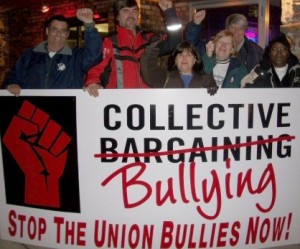 Immediately after the budget vote last month, employees and members of Wisconsin State Employees Union, AFSCME Council 24 began making visits to business owners in Wisconsin asking them to support public unions with a sign in their window. And if a business owner declined, as many did, they got a letter from the union about their refusal to post the sign stating, “failure to do so will leave us no choice but (to) do a public boycott of your business. And sorry, neutral means ‘no’ to those who work for the largest employer in the area and are union members.” Almost immediately the fur began to fly as business owners, the press and even AFSCME members called out the union on what some have argued amounts to illegal conduct. This prompted Council 24 Executive Director Marty Beil to write an e-mail to the local newspaper saying, “There was some unfortunate over zealousness in the field. We have made clear all along that we see small business as a partner, and ally in getting Wisconsin back to work.”[15] Moving beyond all the heart warming stories of communities banding together to stand up to union coercion — we should all take a moment to reflect on what this incident teaches us about who and what really got us all here, and it wasn’t Scott Walker, the Koch Brothers or the ghost of Ronald Reagan. Union leaders don’t try to win or earn support – they simply demand it. And when they don’t get their way they won’t try to better understand objections or work to reach some shared resolution – they just make threats. And when called out on their bad behavior they generally don’t apologize or indulge in any much-needed self-reflection – they just blame some low level staffer. ********* Are You a Good Rich? Or a Bad Rich.
Immediately after the budget vote last month, employees and members of Wisconsin State Employees Union, AFSCME Council 24 began making visits to business owners in Wisconsin asking them to support public unions with a sign in their window. And if a business owner declined, as many did, they got a letter from the union about their refusal to post the sign stating, “failure to do so will leave us no choice but (to) do a public boycott of your business. And sorry, neutral means ‘no’ to those who work for the largest employer in the area and are union members.” Almost immediately the fur began to fly as business owners, the press and even AFSCME members called out the union on what some have argued amounts to illegal conduct. This prompted Council 24 Executive Director Marty Beil to write an e-mail to the local newspaper saying, “There was some unfortunate over zealousness in the field. We have made clear all along that we see small business as a partner, and ally in getting Wisconsin back to work.”[15] Moving beyond all the heart warming stories of communities banding together to stand up to union coercion — we should all take a moment to reflect on what this incident teaches us about who and what really got us all here, and it wasn’t Scott Walker, the Koch Brothers or the ghost of Ronald Reagan. Union leaders don’t try to win or earn support – they simply demand it. And when they don’t get their way they won’t try to better understand objections or work to reach some shared resolution – they just make threats. And when called out on their bad behavior they generally don’t apologize or indulge in any much-needed self-reflection – they just blame some low level staffer. ********* Are You a Good Rich? Or a Bad Rich.
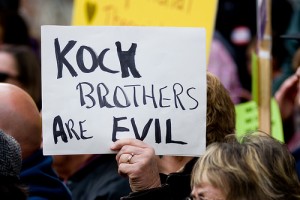 It’s no secret that union types consider the Koch brothers evil incarnate. (Although we think it’s mostly that “Koch” is easy to spell, easy to rhyme and fits nicely on a piece of poster board.) And it doesn’t seem to matter much that the Libertarian brothers blame Republicans as much as Democrats for big government and support a fairly left wing social agenda including gay marriage and the end to military involvement overseas. What’s shocking is how unions are still hectoring the Kochs after the president of the Steelworkers wrote they are actually pretty darn good union employers. “While the Koch brothers are credited with advocating an agenda and groups that are clearly hostile to labor and labor’s agenda, the brothers’ company in practice and in general has positive and productive collective bargaining relationships with its unions. While some companies are running from investment in American jobs, The Koch brothers’ Georgia Pacific just reached agreements with its primary union in the paper industry to invest more than a half a billion dollars in capital to essentially create two state-of-the-art machines that conserve fiber and energy at two separate union mills.” Meanwhile, we are still trying to parse out the moral distinctions between making millions miraculously saving a major corporation and thousands of jobs (Ford CEO Alan Mulally) and making millions creating blowhard documentaries that exploit human suffering while refusing to use union labor. (Michael Moore) Perhaps continuing to dress and groom oneself like the destitute helps.
It’s no secret that union types consider the Koch brothers evil incarnate. (Although we think it’s mostly that “Koch” is easy to spell, easy to rhyme and fits nicely on a piece of poster board.) And it doesn’t seem to matter much that the Libertarian brothers blame Republicans as much as Democrats for big government and support a fairly left wing social agenda including gay marriage and the end to military involvement overseas. What’s shocking is how unions are still hectoring the Kochs after the president of the Steelworkers wrote they are actually pretty darn good union employers. “While the Koch brothers are credited with advocating an agenda and groups that are clearly hostile to labor and labor’s agenda, the brothers’ company in practice and in general has positive and productive collective bargaining relationships with its unions. While some companies are running from investment in American jobs, The Koch brothers’ Georgia Pacific just reached agreements with its primary union in the paper industry to invest more than a half a billion dollars in capital to essentially create two state-of-the-art machines that conserve fiber and energy at two separate union mills.” Meanwhile, we are still trying to parse out the moral distinctions between making millions miraculously saving a major corporation and thousands of jobs (Ford CEO Alan Mulally) and making millions creating blowhard documentaries that exploit human suffering while refusing to use union labor. (Michael Moore) Perhaps continuing to dress and groom oneself like the destitute helps. *********** Not Your Dad’s UAW  Through three decades of steady decline, the United Auto Workers has projected somewhat of a “we’ve got ours” attitude towards new organizing. Not anymore. Under the leadership of radical activist Bob King, for the first time since 2005, the UAW gained members in 2010adding over 21,000 members. (The union’s membership in 2009 was the lowest it had been since 1940.) Increased production at the Big Three accounted for the majority of those new UAW members, but the union has also been aggressive organizing outside of manufacturing in casinos, healthcare, colleges and other sectors. And the union will soon announce the target of its most aggressive organizing effort in recent memory – a foreign auto manufacturer with plants in the southern U.S. Over the past year the union has been building what amounts to a global army of young activists trained in the U.S. to attack transnational corporations wherever they do business. Tactics will include protests at dealerships, auto shows, overseas headquarters and even World Cup matches. Richard Besinger, legendary organizing guru hired to run UAW organizing, has stated the union will mount the largest boycott in history this summer calling on political, community and left wing allies as well as other unions here and abroad for support. “It has the potential to be the largest, sustained consumer action by organized labor,” said Dennis Williams, the UAW Secretary Treasurer, “We have the resources and the people to be successful in this mission.” Newly trained college recruits have already begun knocking doors in communities with auto plants in Alabama, Mississippi and Tennessee trolling for issues and shop floor activists. However, “it is pretty hard to see the union breaking through,” according to James Rubenstein, an auto industry analyst. “It would have to be a plant where the working conditions have gotten so bad that people are up in arms and furious with management. There really aren’t any bad factories anymore. These plants are now warm and fuzzy.” The pay differential between union and non-union auto plants is now around $10 an hour with new “second tier” UAW workers making considerably less than their non-union counterparts.
Through three decades of steady decline, the United Auto Workers has projected somewhat of a “we’ve got ours” attitude towards new organizing. Not anymore. Under the leadership of radical activist Bob King, for the first time since 2005, the UAW gained members in 2010adding over 21,000 members. (The union’s membership in 2009 was the lowest it had been since 1940.) Increased production at the Big Three accounted for the majority of those new UAW members, but the union has also been aggressive organizing outside of manufacturing in casinos, healthcare, colleges and other sectors. And the union will soon announce the target of its most aggressive organizing effort in recent memory – a foreign auto manufacturer with plants in the southern U.S. Over the past year the union has been building what amounts to a global army of young activists trained in the U.S. to attack transnational corporations wherever they do business. Tactics will include protests at dealerships, auto shows, overseas headquarters and even World Cup matches. Richard Besinger, legendary organizing guru hired to run UAW organizing, has stated the union will mount the largest boycott in history this summer calling on political, community and left wing allies as well as other unions here and abroad for support. “It has the potential to be the largest, sustained consumer action by organized labor,” said Dennis Williams, the UAW Secretary Treasurer, “We have the resources and the people to be successful in this mission.” Newly trained college recruits have already begun knocking doors in communities with auto plants in Alabama, Mississippi and Tennessee trolling for issues and shop floor activists. However, “it is pretty hard to see the union breaking through,” according to James Rubenstein, an auto industry analyst. “It would have to be a plant where the working conditions have gotten so bad that people are up in arms and furious with management. There really aren’t any bad factories anymore. These plants are now warm and fuzzy.” The pay differential between union and non-union auto plants is now around $10 an hour with new “second tier” UAW workers making considerably less than their non-union counterparts. 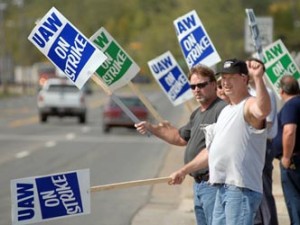 The union also laid the groundwork at its bargaining convention last week for a strike against Ford this year. Ford has the only contract without a strike clause and has rebounded from the recession beyond every expectation. Union campaign rhetoric has already started on Ford’s profits and CEO compensation, even as the company paid out $5000 in profit sharing to every hourly employee in January, $2000 above the formula laid out in the UAW bargaining agreement. ********* The GOP’s Pro-Union Sixteen
The union also laid the groundwork at its bargaining convention last week for a strike against Ford this year. Ford has the only contract without a strike clause and has rebounded from the recession beyond every expectation. Union campaign rhetoric has already started on Ford’s profits and CEO compensation, even as the company paid out $5000 in profit sharing to every hourly employee in January, $2000 above the formula laid out in the UAW bargaining agreement. ********* The GOP’s Pro-Union Sixteen
 The following sixteen House Republicans voted for the amendment to the FAA bill that would have restored union friendly election standards. Rep. Michael Grimm, R-N.Y. Rep. Walter Jones, R-N.C. Rep. Tim Johnson, R-Ill. Rep. Todd Platts, R-Pa. Rep. Dave Reichert, R-Wash. Rep. David Rivera, R-Fla. Rep. Ileana Ros-Lehtinen, R-Fla. Rep. Jon Runyan, R-N.J. Rep. Mario Diaz-Balart, R-Fla. Rep. Pete King, R.-N.Y. Rep. Steve LaTourette, R.-Ohio Rep. Frank LoBiondo, R-N.J. Rep. Chris Smith, R-N.J. Rep. Jo Ann Emerson, R-Mo. Rep. Chris Gibson, R-N.Y. Rep. Don Young , R-Alaska LaTourette from Ohio rises to the top of this class for having co-sponsored the amendment.
The following sixteen House Republicans voted for the amendment to the FAA bill that would have restored union friendly election standards. Rep. Michael Grimm, R-N.Y. Rep. Walter Jones, R-N.C. Rep. Tim Johnson, R-Ill. Rep. Todd Platts, R-Pa. Rep. Dave Reichert, R-Wash. Rep. David Rivera, R-Fla. Rep. Ileana Ros-Lehtinen, R-Fla. Rep. Jon Runyan, R-N.J. Rep. Mario Diaz-Balart, R-Fla. Rep. Pete King, R.-N.Y. Rep. Steve LaTourette, R.-Ohio Rep. Frank LoBiondo, R-N.J. Rep. Chris Smith, R-N.J. Rep. Jo Ann Emerson, R-Mo. Rep. Chris Gibson, R-N.Y. Rep. Don Young , R-Alaska LaTourette from Ohio rises to the top of this class for having co-sponsored the amendment. ********** Who Really Buys Political Influence?
 Open Secrets and the Center for Responsive Politics have compiled a list of the top 140 political donors in federal politics since 1989. Of the top ten donors five are unions — AFSCME (3), IBEW (7), NEA (8), Laborers (9) and Teamsters (10). The top spot belongs to ActBlue, the Obama netroot money raiser. AT&T comes in second, followed by Goldman Sachs (5) and the American Association for Justice (6) (lawyers who donate 90% to Democrats). Of the next fifteen, seven are unions — Carpenters (11), SEIU (12), AFT (13), CWA (14), UAW (17), Machinists (19) and the UFCW (21). Emily’s List, with 99% of its donations going to Democrats, comes in 25th. Thirteen additional unions come in ahead of Koch Industries in 83rd place, Walmart at 89th and AIG at 100th. The Club for Growth came in 78th and Bank of America, another frequent target of Big Labor, came in at 38th on the list.
Open Secrets and the Center for Responsive Politics have compiled a list of the top 140 political donors in federal politics since 1989. Of the top ten donors five are unions — AFSCME (3), IBEW (7), NEA (8), Laborers (9) and Teamsters (10). The top spot belongs to ActBlue, the Obama netroot money raiser. AT&T comes in second, followed by Goldman Sachs (5) and the American Association for Justice (6) (lawyers who donate 90% to Democrats). Of the next fifteen, seven are unions — Carpenters (11), SEIU (12), AFT (13), CWA (14), UAW (17), Machinists (19) and the UFCW (21). Emily’s List, with 99% of its donations going to Democrats, comes in 25th. Thirteen additional unions come in ahead of Koch Industries in 83rd place, Walmart at 89th and AIG at 100th. The Club for Growth came in 78th and Bank of America, another frequent target of Big Labor, came in at 38th on the list. Together, the twenty-nine unions in the top donor list contributed $602M over ten years, with 95% going to Democrats. This figure would not include non-cash donations of manpower, mail, equipment and facilities on and off the books or funds filtered through front organizations like America Votes which likely dwarf cash contributions. ********** History, Hyperbole and Murals 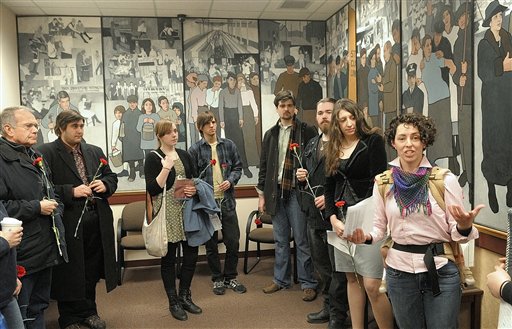 Much ado about less than nothing has been brewing in Maine over the past two weeks, especially since Governor LePage followed up on his threat to remove a pedestrian mural called “The History of Labor in the State of Maine” that hung in the lobby of the Maine Department of Labor. LePage claims business people found the mural offensive, comparing it to North Korean propaganda; the AFL-CIO is calling the removal of it “akin to actions of totalitarian regimes.” We suspect the truth lies somewhere in between. 1. Maybe it doesn’t look like North Korean propaganda but it sure does look like propaganda of some sort, perhaps Soviet Era, which had a more gloomy tenor than Kim Jong-il generally allows. The Maine mural does have a Commie varnish to it with its downtrodden workers freed from capitalist oppression dancing under the banner of collectivism. But it’s most definitely not North Korean or there would be a lot more blue skies and flowers. 2. The mural does indeed make the Maine business community look lousy, as the only employers in the piece are exploiters, profiteers and head-busters. Apparently, were it not for the sweet mercy of that union vote in panel four, Maine businesses would still be sending kids into mines clutching their little lunch pails and lashing teenage mill girls to their looms. 3. The mural itself isn’t history and its slanted marginalized portrayal of history is served with one walloping dollop of artistic license. It’s also only a few years old and has most likely gone largely unnoticed until a month ago. (It did hang in the Maine Department of Labor after all!) So taking the mural down or even setting it on fire doesn’t destroy history, or rewrite it or erase it or slap it or Frances Perkins in the face. It’s a piece of art that some people don’t appreciate and people in power have been sending art they don’t appreciate to the world’s basements since the dawn of, well, history. 4. Sure it was bad timing and perhaps petty to take it down, but it wasn’t criminal and it wasn’t the end of Democracy as we know it. The governor didn’t destroy it, he moved it and once Democracy is restored to the State of Maine the next governor can move it back. Unless DePage cancels elections – THEN Maine has a problem! ********** Social Media Spotlight: MNA
Much ado about less than nothing has been brewing in Maine over the past two weeks, especially since Governor LePage followed up on his threat to remove a pedestrian mural called “The History of Labor in the State of Maine” that hung in the lobby of the Maine Department of Labor. LePage claims business people found the mural offensive, comparing it to North Korean propaganda; the AFL-CIO is calling the removal of it “akin to actions of totalitarian regimes.” We suspect the truth lies somewhere in between. 1. Maybe it doesn’t look like North Korean propaganda but it sure does look like propaganda of some sort, perhaps Soviet Era, which had a more gloomy tenor than Kim Jong-il generally allows. The Maine mural does have a Commie varnish to it with its downtrodden workers freed from capitalist oppression dancing under the banner of collectivism. But it’s most definitely not North Korean or there would be a lot more blue skies and flowers. 2. The mural does indeed make the Maine business community look lousy, as the only employers in the piece are exploiters, profiteers and head-busters. Apparently, were it not for the sweet mercy of that union vote in panel four, Maine businesses would still be sending kids into mines clutching their little lunch pails and lashing teenage mill girls to their looms. 3. The mural itself isn’t history and its slanted marginalized portrayal of history is served with one walloping dollop of artistic license. It’s also only a few years old and has most likely gone largely unnoticed until a month ago. (It did hang in the Maine Department of Labor after all!) So taking the mural down or even setting it on fire doesn’t destroy history, or rewrite it or erase it or slap it or Frances Perkins in the face. It’s a piece of art that some people don’t appreciate and people in power have been sending art they don’t appreciate to the world’s basements since the dawn of, well, history. 4. Sure it was bad timing and perhaps petty to take it down, but it wasn’t criminal and it wasn’t the end of Democracy as we know it. The governor didn’t destroy it, he moved it and once Democracy is restored to the State of Maine the next governor can move it back. Unless DePage cancels elections – THEN Maine has a problem! ********** Social Media Spotlight: MNA 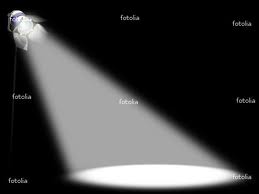 The Minnesota Nurses Association is one union to watch when it comes to social media organizing and any employer still complacent about social media organizing should take notice. In an MNA SlideShare presentation, the union lays out how it uses Facebook to network and engage not just its members, but patients, celebrities, politicians and the general public. Facebook also allows the union to share stories, flyers and videos with members, the media and a complex web of union friendlies during campaigns. It’s also worthwhile to see how the union dominates media coverage in this YouTube video. Be sure to visit the LRI Union Free YouTube Channel to view this and other entertaining and informative videos. ********** SEIU Watch: NYC Living Wage
The Minnesota Nurses Association is one union to watch when it comes to social media organizing and any employer still complacent about social media organizing should take notice. In an MNA SlideShare presentation, the union lays out how it uses Facebook to network and engage not just its members, but patients, celebrities, politicians and the general public. Facebook also allows the union to share stories, flyers and videos with members, the media and a complex web of union friendlies during campaigns. It’s also worthwhile to see how the union dominates media coverage in this YouTube video. Be sure to visit the LRI Union Free YouTube Channel to view this and other entertaining and informative videos. ********** SEIU Watch: NYC Living Wage
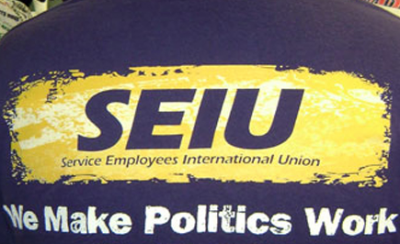 The Association for Better Healthcare, an organization that represents licensed home care agencies in New York has lashed out against a “political deal” between New York’s Governor Andrew Cuomo and SEIU 1199. The governor, a longtime comrade of 1199, is ramming through“living wage” legislation for home care workers. The provision would require agencies in the city and three adjacent counties to pay their aides a yet to be determined “living wage” that is expected to drive all but the largest agencies out of business. The provision will immediately pay off for SEIU as home care workers’ dues are calculated as a percentage of pay. SEIU will also gain big in the long haul as the Association predicts thousands of jobs will eventually shift to a few large agencies and those already unionized. That consolidation would make wall-to-wall organizing far easier than it is with the existing patchwork of hundreds of smaller employers. Even though a “living wage” could cost the cash strapped state an additional $400 million in Medicaid costs the last minute deal was needed to broker the support of 1199 for the rest of Cuomo’s austerity budget. Dennis Rivera, former president of 1199 and now International “advisor,” co-chaired Cuomo’s Medicaid Redesign Team that proposed the massive wage hike. 1199 is considered to be perhaps the single most powerful force in New York Democrat politics with its annual political donations of close to a million dollars dwarfed by the value of the massive local’s call center and legendary ability to put GOTV boots on the ground. Cornered by a bold and brilliant political move some are comparing to three level chess, and with drastic budget cuts on the table along with Cuomo’s political destiny, NY Democrats just don’t know how to say no to 1199.
The Association for Better Healthcare, an organization that represents licensed home care agencies in New York has lashed out against a “political deal” between New York’s Governor Andrew Cuomo and SEIU 1199. The governor, a longtime comrade of 1199, is ramming through“living wage” legislation for home care workers. The provision would require agencies in the city and three adjacent counties to pay their aides a yet to be determined “living wage” that is expected to drive all but the largest agencies out of business. The provision will immediately pay off for SEIU as home care workers’ dues are calculated as a percentage of pay. SEIU will also gain big in the long haul as the Association predicts thousands of jobs will eventually shift to a few large agencies and those already unionized. That consolidation would make wall-to-wall organizing far easier than it is with the existing patchwork of hundreds of smaller employers. Even though a “living wage” could cost the cash strapped state an additional $400 million in Medicaid costs the last minute deal was needed to broker the support of 1199 for the rest of Cuomo’s austerity budget. Dennis Rivera, former president of 1199 and now International “advisor,” co-chaired Cuomo’s Medicaid Redesign Team that proposed the massive wage hike. 1199 is considered to be perhaps the single most powerful force in New York Democrat politics with its annual political donations of close to a million dollars dwarfed by the value of the massive local’s call center and legendary ability to put GOTV boots on the ground. Cornered by a bold and brilliant political move some are comparing to three level chess, and with drastic budget cuts on the table along with Cuomo’s political destiny, NY Democrats just don’t know how to say no to 1199. ********** Sticky Fingers Current charges or sentences of embezzling union officials:
| Jesse Daniels | USW | $19,500 |
| Heather Hill | Ironworkers | $59,653.12 |
| Tracy Ford | IAM | $175,000 |
| Donna Cooper | LIUNA | $69,322 |
